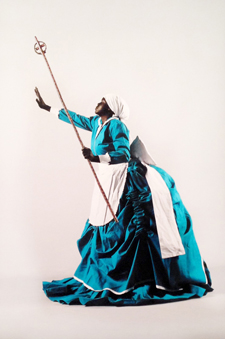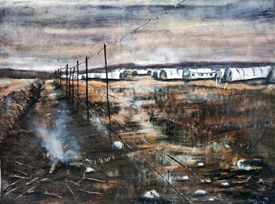CAA News Today
You never know where opportunities will lead you…
posted by Karen von Veh — Sep 09, 2015
Karen von Veh is associate professor of art history at the University of Johannesburg in South Africa and participant in the 2013 CAA-Getty International Program.
In 2013 I was one of the lucky recipients of a Getty travel grant to attend the CAA Annual Conference in New York. The first time I met the other grantees was when we had to give a short presentation about our research interests and show examples of the work we were studying. Ding Ning from Peking University was one of our group. Shortly after we returned to our home countries, he contacted me to ask about the possibility of showcasing the art of South Africa as an invited “special exhibition” for the Beijing Biennale in September 2015. Each year the biennale invites selected countries to produce what they call “special exhibitions” and to date they have never had exhibitions from anywhere in Africa. An exhibition of South African art would therefore be a “first” for them and a huge opportunity for us in South Africa—not only to showcase the excellence of our art production but also to align with the drive for cooperation between the BRICS nations (Brazil, Russia, India, China, and South Africa) and the various cultural and economic exchange programs that are currently underway.
Special exhibitions at the Beijing Biennale are expected to be showcases of the invited country’s cultural (fine art) production, and we decided to use this exhibition to reflect on the perceived state of our fledgling democracy. After the long struggle to introduce a democratic system and freedom for all in South Africa, one might imagine that an exhibition reflecting the current state of our democratic society might be a very cheerful and upbeat affair. However, twenty-one years after apartheid, we are still seeing the aftereffects of institutionalized inequalities, and the pace of change is not necessarily fulfilling citizen’s expectations. Annie E. Coombes’s book, History after Apartheid: Visual Culture and Public Memory in a Democratic South Africa (Durham, NC: Duke University Press, 2003), argues that cultural manifestations both reflect and affect this change in social structures and relationships. Transition is a difficult state to occupy; often beliefs or behavioral practices are so normalized that change is virtually impossible without a catalyst to shake us out of complacency and awaken us to the possibilities of alternative practices and thoughts. I believe that intellectually engaged, socially conscious art is just such a catalyst.
Bearing this in mind, my cocurators and I have chosen works by a cross section of high profile established artists—those who have been part of the struggle toward democracy and who have seen and reacted to both the good and the bad changes brought about by the new dispensation (William Kentridge, Diane Victor and David Koloane would be examples of this category). These artists have established careers and are well known at home and internationally. In addition, we made a careful selection of young emerging contemporary artists who we believe are embarking on successful careers and who have something pertinent to say about the condition of our society for the future of the youth. All the artists selected acknowledge the role of contemporary art in South Africa as a catalyst for change and raise social and political issues. Their work comments on the real impact of twenty-one years of democracy—a democracy that has allowed them the artistic freedom to comment incisively on some of the continuing challenges arising from inherited and ongoing inequality in society. The chosen examples also illustrate South Africa’s achievements in various traditional media (drawing, painting, printmaking, sculpture) and, in addition, we have included some examples of digital media and/or mixed-media works.
As I write this, we are packing up the works for transport to China and preparing to travel there ourselves in mid-September to set up the exhibition. Thinking back to the initial invitation to visit New York in 2013, I had no conception at the time of where this opportunity might lead in the future, and what fruitful projects might come from the contacts made on this occasion.
Kim Berman’s monotype is a reminder of the 2009 xenophobic attacks in South Africa. She records the tented camps put up by local authorities and aid organizations to house dispossessed foreigners, who were victims of violence and intimidation. A barbed-wire fence running through the center of the image is reminiscent of records from the Anglo Boer War concentration camps of the early 1900s. Berman is perhaps suggesting that little has changed in terms of difference, intolerance, and unequal power relations.
Image: Kim Berman, Rifle Range I, Roodepoort, 2009, monotype, 78 x 108 cm (artwork © Kim Berman)

Mary Sibande performs her alter ego, Sophie, clad in Victorian attire. The color of her dress refers to the Zionist Christian Church (ZCC) uniform, and she is wielding a Zionist prayer stick. Sibande refers to the conflation of Christianity and traditions of ancestral worship that exist within the ZCC. This cultural overlap illustrates her search for identity as a young black woman living in the Westernized culture of contemporary South Africa. Her Sophie persona thus explores postcolonial South African identity and critiques stereotypical depictions of women, especially black women, in society.
Image: Mary Sibande, I put a spell on me, 2009, digital pigment print, 90 x 60 cm (artwork © Mary Sibande)



